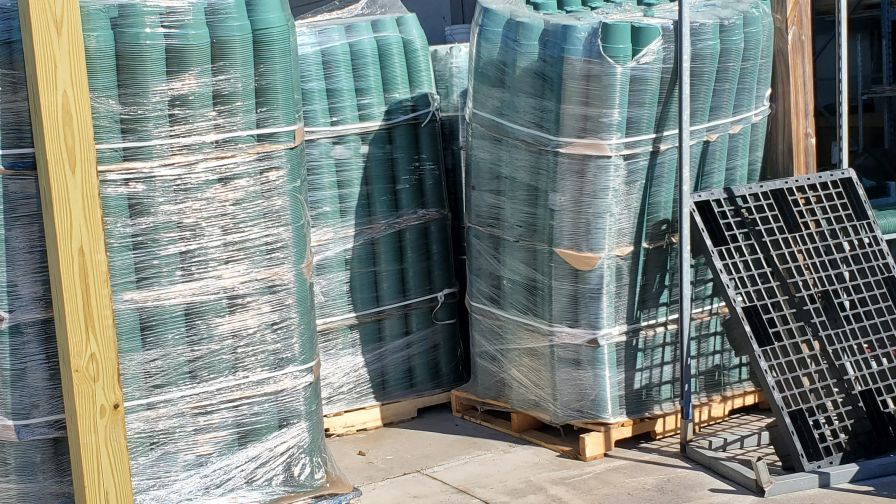2023 Outlook for Plant Pots and Trays

Longer lead times are still in play for pots and trays. Forecasting is key in making sure everyone can get the products they need. Photo: Janeen Wright
Sourcing pots, trays, and other plastics goods from overseas on time has been a challenge for a while, and indications are that some unpredictability in the supply chain will linger into 2023. While a return to normalcy is in sight for pots and trays, advance planning, flexibility, and early communication with your supplier partners are still the best ways to ensure you have the products you need for your production needs.
Greenhouse Grower reached out to pots and trays suppliers to get their take on the supply chain and the outlook for 2023. Ken Fisher, General Manager for Orora Visual and Jared Rusch, Vice President of Sales and Marketing – Horticulture for T.O. Plastics, shared their perspectives on the state of the industry regarding pots and trays. Please note: Answers are regarding materials Orora Visual Horticulture and T.O. Plastics use in the production of the products they offer to their customers.
Greenhouse Grower (GG): What is your current view of the state of the industry for pots and trays?
Ken Fisher: The current state of the industry continues to be challenging and quite dynamic. An unpredictable supply chain is still the norm.
Jared Rusch: The market is beginning to stabilize from the exponential growth and supply chain challenges that we faced in the last couple of years. Some customers have scaled back on their spring projections, but overall, the demand for our product remains high.
GG: What are some current trends or influences shaping or impacting the plastics industry right now regarding pots, trays, etc.?
Fisher: The growers’ need for input cost reduction is causing material demand to shift to alternative products/materials that aren’t currently available to meet this new demand, which is driving up costs.
Rusch: Automation compatibility is becoming key as labor has become scarce. We have done a lot of work making our current products compatible with automation as well as ensuring our new product launches have that capability as well. Customers have had to become a little more flexible over the last couple of years of supply chain issues and increased demand. We expect that to continue as well.
GG: What is happening with conditions in your supply chain? How are things looking with your supply chain for 2023 and beyond?
Fisher: Spikes in finished goods demand over the past two years put increased pressure on the availability of raw materials. As a result, some suppliers changed their business strategies and left the supply chain, which resulted in secondary material supply shortages. [2023 and beyond]. With the possibility of a soft economy negatively impacting sales, we may see a return to a more stable, predictable supply chain. It’s still best for growers to plan ahead and determine where there is flexibility in their business to allow for options — should they be needed.
Rusch: We’ve done a lot of work getting our raw material capacity increased to meet the increased demand. All our reclaimed material is post-industrial recycled material, and we have ensured a healthy supply through many capital projects in the last 12 to 18 months. Looking into 2023 and 2024, we are very confident that our supply will remain strong.
GG: What are your predictions for pots and trays for 2023? What should greenhouse growers be aware of for 2023 and beyond?
Fisher: Overall, consumer demand is softening and coming back in line with pre-pandemic levels. To the extent this continues, we should also see some resumption of “normal” in the supply chain. For growers, plan, plan, plan. Uncertainty in the supply chain will continue. The earlier suppliers are aware of growers’ needs, the better we can support their business plans by working with and affecting our supplier networks.
Rusch: While lead times are slowing, they are still in play. Growers should be looking ahead to their 2023 and 2024 needs and continue to plan for those purchases now. Forecasting is key in making sure everyone can get the products they need. Overall, demand will continue to be strong, but perhaps not to the level of the last couple of years. Focusing on the different trends in the market and what the end users are requesting will be vital to long-term success.
What will your company be focusing on in 2023?
Fisher: Innovation and Sustainability — keeping the consumer top of mind by supporting the best shopper experience possible.
Rusch: T.O. Plastics is putting a big emphasis on raw material processing and improving our operational efficiencies. From adding new machinery to optimizing our current lines, we continue to look to grow. We have made substantial investments to increase our overall production capacity to meet our customer demand. We are also excited about the new products that we will be launching next year and the year after. Our Sales and Engineering teams are hard at work to finalize these projects for an on-time launch.









